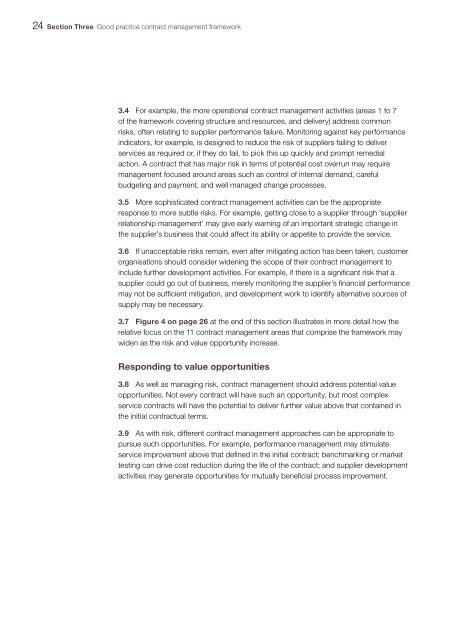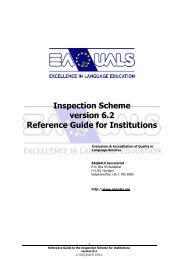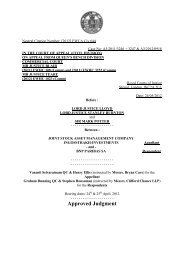Good practice contract management framework - Support
Good practice contract management framework - Support
Good practice contract management framework - Support
Create successful ePaper yourself
Turn your PDF publications into a flip-book with our unique Google optimized e-Paper software.
24 Section Three <strong>Good</strong> <strong>practice</strong> <strong>contract</strong> <strong>management</strong> <strong>framework</strong><br />
3.4 For example, the more operational <strong>contract</strong> <strong>management</strong> activities (areas 1 to 7<br />
of the <strong>framework</strong> covering structure and resources, and delivery) address common<br />
risks, often relating to supplier performance failure. Monitoring against key performance<br />
indicators, for example, is designed to reduce the risk of suppliers failing to deliver<br />
services as required or, if they do fail, to pick this up quickly and prompt remedial<br />
action. A <strong>contract</strong> that has major risk in terms of potential cost overrun may require<br />
<strong>management</strong> focused around areas such as control of internal demand, careful<br />
budgeting and payment, and well managed change processes.<br />
3.5 More sophisticated <strong>contract</strong> <strong>management</strong> activities can be the appropriate<br />
response to more subtle risks. For example, getting close to a supplier through ‘supplier<br />
relationship <strong>management</strong>’ may give early warning of an important strategic change in<br />
the supplier’s business that could affect its ability or appetite to provide the service.<br />
3.6 If unacceptable risks remain, even after mitigating action has been taken, customer<br />
organisations should consider widening the scope of their <strong>contract</strong> <strong>management</strong> to<br />
include further development activities. For example, if there is a significant risk that a<br />
supplier could go out of business, merely monitoring the supplier’s financial performance<br />
may not be sufficient mitigation, and development work to identify alternative sources of<br />
supply may be necessary.<br />
3.7 Figure 4 on page 26 at the end of this section illustrates in more detail how the<br />
relative focus on the 11 <strong>contract</strong> <strong>management</strong> areas that comprise the <strong>framework</strong> may<br />
widen as the risk and value opportunity increase.<br />
Responding to value opportunities<br />
3.8 As well as managing risk, <strong>contract</strong> <strong>management</strong> should address potential value<br />
opportunities. Not every <strong>contract</strong> will have such an opportunity, but most complex<br />
service <strong>contract</strong>s will have the potential to deliver further value above that contained in<br />
the initial <strong>contract</strong>ual terms.<br />
3.9 As with risk, different <strong>contract</strong> <strong>management</strong> approaches can be appropriate to<br />
pursue such opportunities. For example, performance <strong>management</strong> may stimulate<br />
service improvement above that defined in the initial <strong>contract</strong>; benchmarking or market<br />
testing can drive cost reduction during the life of the <strong>contract</strong>; and supplier development<br />
activities may generate opportunities for mutually beneficial process improvement.





![[2012] UKUT 399 (TCC)](https://img.yumpu.com/51352289/1/184x260/2012-ukut-399-tcc.jpg?quality=85)





![Neutral Citation Number: [2009] EWHC 3198 (Ch) Case No: CH ...](https://img.yumpu.com/50120201/1/184x260/neutral-citation-number-2009-ewhc-3198-ch-case-no-ch-.jpg?quality=85)





